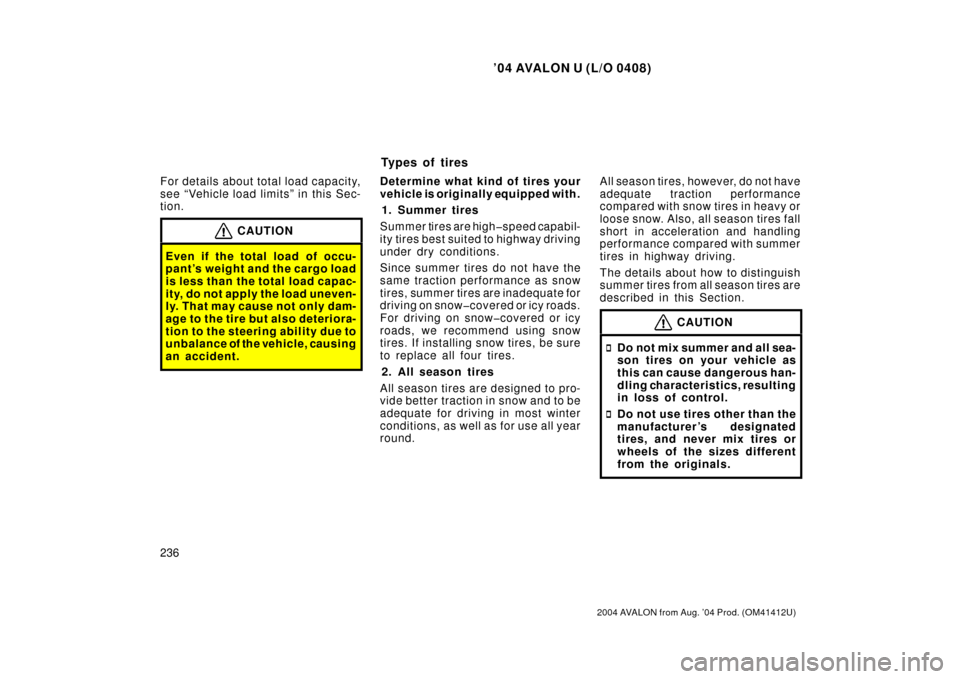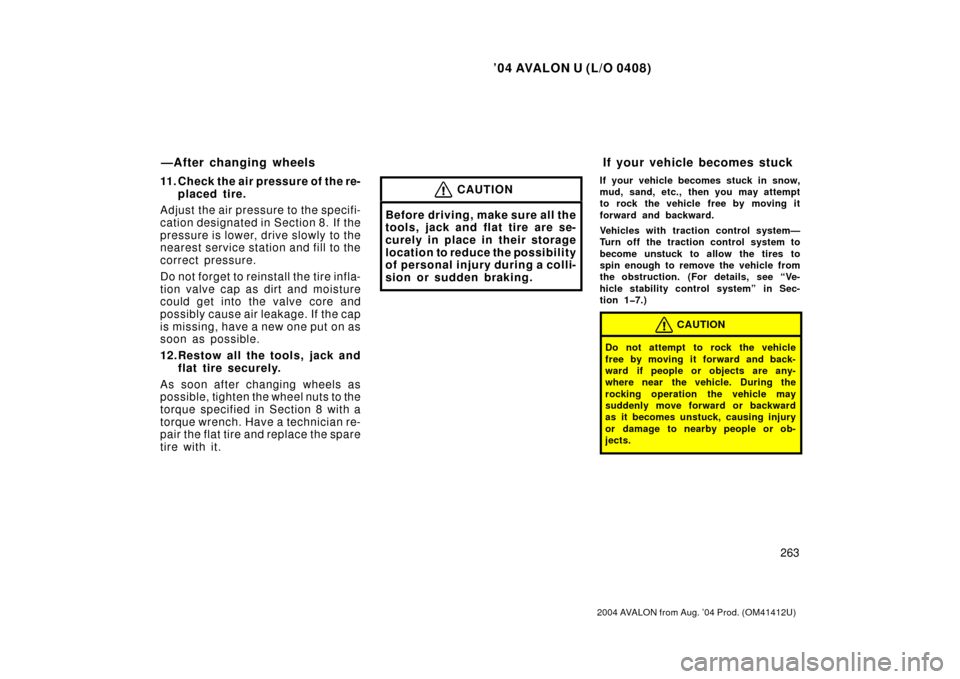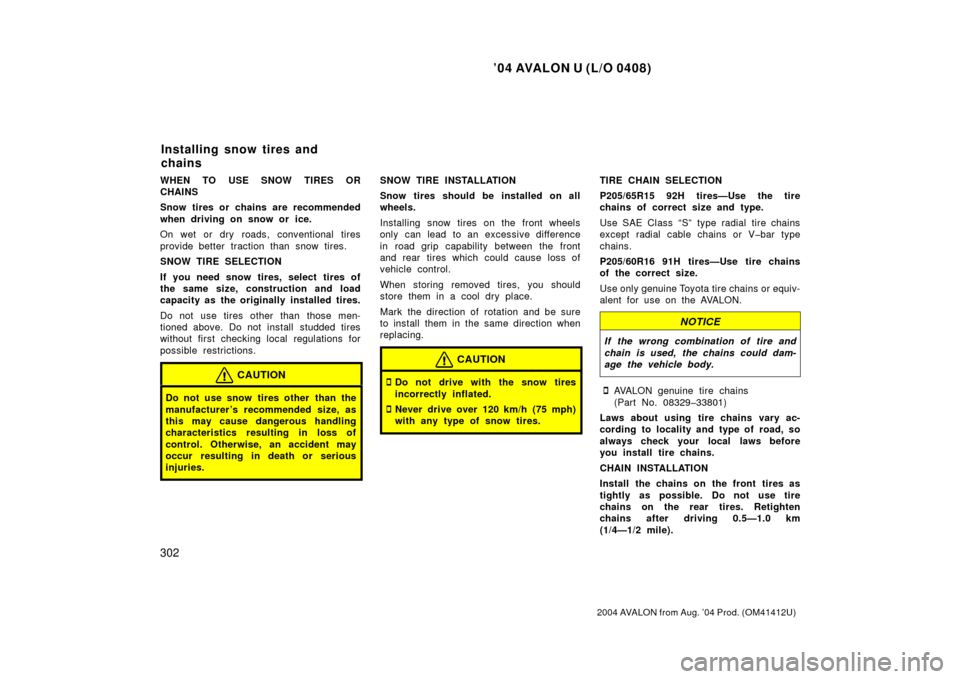Page 236 of 339

’04 AVALON U (L/O 0408)
228
2004 AVALON from Aug. ’04 Prod. (OM41412U)
This information has been prepared
in accordance with regulations issued
by the National Highway Traffic Safe-
ty Administration of the U.S. Depart-
ment of Transportation. It provides
the purchasers and/or prospective
purchasers of Toyota vehicles with in-
formation on uniform tire quality grad-
ing.
Your Toyota dealer will help answer
any questions you may have as you
read this information.
DOT quality grades—All passenger
vehicle tires must conform to Fed-
eral Safety Requirements in addi-
tion to these grades. Quality
grades can be found where appli-
cable on the tire sidewall between
tread shoulder and maximum sec-
tion width. For example: Treadwear
200 Traction AA Temperature ATreadwear—
The treadwear grade is
a comparative rating based on the
wear rate of the tire when tested un-
der controlled conditions on a speci-
fied government test course. For ex-
ample, a tire graded 150 would wear
one and a half (1�1/2) times as well
on the government course as a tire
graded 100. The relative performance
of tires depends upon the actual
conditions of their use, however, and
may depart significantly from the
norm due to variations in driving hab-
its, service practices and differences
in road characteristics and climate. Traction AA, A, B, C—
The traction
grades, from highest to lowest, are
AA, A, B, and C, and they represent
the tire’s ability to stop on wet pave-
ment as measured under controlled
conditions on specified government
test surfaces of asphalt and concrete.
A tire marked C may have poor trac-
tion performance.
Warning: The traction grade assigned
to this tire is based on braking
(straight ahead) traction tests and
does not include cornering (turning)
traction.
—Uniform tire quality grading
Page 244 of 339

’04 AVALON U (L/O 0408)
236
2004 AVALON from Aug. ’04 Prod. (OM41412U)
For details about total load capacity,
see “Vehicle load limits” in this Sec-
tion.
CAUTION
Even if the total load of occu-
pant’s weight and the cargo load
is less than the total load capac-
ity, do not apply the load uneven-
ly. That may cause not only dam-
age to the tire but also deteriora-
tion to the steering ability due to
unbalance of the vehicle, causing
an accident.
Determine what kind of tires your
vehicle is originally equipped with.1. Summer tires
Summer tires are high�speed capabil-
ity tires best suited to highway driving
under dry conditions.
Since summer tires do not have the
same traction performance as snow
tires, summer tires are inadequate for
driving on snow�covered or icy roads.
For driving on snow�covered or icy
roads, we recommend using snow
tires. If installing snow tires, be sure
to replace all four tires.
2. All season tires
All season tires are designed to pro-
vide better traction in snow and to be
adequate for driving in most winter
conditions, as well as for use all year
round. All season tires, however, do not have
adequate traction performance
compared with snow tires in heavy or
loose snow. Also, all season tires fall
short in acceleration and handling
performance compared with summer
tires in highway driving.
The details about how to distinguish
summer tires from all season tires are
described in this Section.
CAUTION
�
Do not mix summer and all sea-
son tires on your vehicle as
this can cause dangerous han-
dling characteristics, resulting
in loss of control.
� Do not use tires other than the
manufacturer’s designated
tires, and never mix tires or
wheels of the sizes different
from the originals.
Types of tires
Page 271 of 339

’04 AVALON U (L/O 0408)
263
2004 AVALON from Aug. ’04 Prod. (OM41412U)
11. Check the air pressure of the re-placed tire.
Adjust the air pressu re to the specifi-
cation designated in Section 8. If the
pressure is lower, drive slowly to the
nearest service station and fill to the
correct pressure.
Do not forget to reinstall the tire infla-
tion valve cap as dirt and moisture
could get into the valve core and
possibly cause air leakage. If the cap
is missing, have a new one put on as
soon as possible.
12.Restow all the tools, jack and flat tire securely.
As soon after changing wheels as
possible, tighten the wheel nuts to the
torque specified in Section 8 with a
torque wrench. Have a technician re-
pair the flat tire and replace the spare
tire with it.CAUTION
Before driving, make sure all the
tools, jack and flat tire are se-
curely in place in their storage
location to reduce the possibility
of personal injury during a colli-
sion or sudden braking.
If your vehicle becomes stuck in snow,
mud, sand, etc., then you may attempt
to rock the vehicle free by moving it
forward and backward.
Vehicles with traction control system—
Turn off the traction control system to
become unstuck to allow the tires to
spin enough to remove the vehicle from
the obstruction. (For details, see “Ve-
hicle stability control system” in Sec-
tion 1�7.)
CAUTION
Do not attempt to rock the vehicle
free by moving it forward and back-
ward if people or objects are any-
where near the vehicle. During the
rocking operation the vehicle may
suddenly move forward or backward
as it becomes unstuck, causing injury
or damage to nearby people or ob-
jects.
—After changing wheels If your vehicle becomes stuck
Page 310 of 339

’04 AVALON U (L/O 0408)
302
2004 AVALON from Aug. ’04 Prod. (OM41412U)
WHEN TO USE SNOW TIRES OR
CHAINS
Snow tires or chains are recommended
when driving on snow or ice.
On wet or dry roads, conventional tires
provide better traction than snow tires.
SNOW TIRE SELECTION
If you need snow tires, select tires of
the same size, construction and load
capacity as the originally installed tires.
Do not use tires other than those men-
tioned above. Do not install studded tires
without first checking local regulations for
possible restrictions.
CAUTION
Do not use snow tires other than the
manufacturer ’s recommended size, as
this may cause dangerous handling
characteristics resulting in loss of
control. Otherwise, an accident may
occur resulting in death or serious
injuries.
SNOW TIRE INSTALLATION
Snow tires should be installed on all
wheels.
Installing snow tires on the front wheels
only can lead to an excessive difference
in road grip capability between the front
and rear tires which could cause loss of
vehicle control.
When storing removed tires, you should
store them in a cool dry place.
Mark the direction of rotation and be sure
to install them in the same direction when
replacing.
CAUTION
�Do not drive with the snow tires
incorrectly inflated.
�Never drive over 120 km/h (75 mph)
with any type of snow tires.
TIRE CHAIN SELECTION
P205/65R15 92H tires—Use the tire
chains of correct size and type.
Use SAE Class “S” type radial tire chains
except radial cable chains or V�bar type
chains.
P205/60R16 91H tires—Use tire chains
of the correct size.
Use only genuine Toyota tire chains or equiv-
alent for use on the AVALON.
NOTICE
If the wrong combination of tire and
chain is used, the chains could dam-
age the vehicle body.
�AVALON genuine tire chains
(Part No. 08329�33801)
Laws about using tire chains vary ac-
cording to locality and type of road, so
always check your local laws before
you install tire chains.
CHAIN INSTALLATION
Install the chains on the front tires as
tightly as possible. Do not use tire
chains on the rear tires. Retighten
chains after driving 0.5—1.0 km
(1/4—1/2 mile).
Installing snow tires and
chains
Page:
< prev 1-8 9-16 17-24